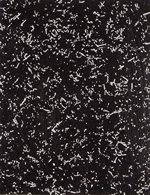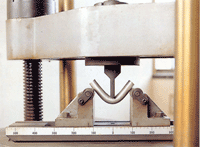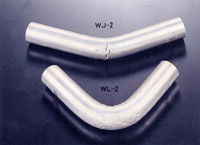
ホワイトメタル:White Metal
アサヒメタルのスペシャル・ホワイトメタル:Special White Metal
WL-2, SC-371
舶用ディーゼルエンジンの大型化及び過給機の装備による高出力化に伴いエンジンの平均有効圧力が高くなり、 クランクやクロスヘッドピン軸等の大きな変動荷重を受けるホワイトメタル軸受は、極めて厳しい使用条件が要求されるようになっています。 従来のホワイトメタルでは亀裂・剥離などの損傷がおきるようになり、 このためクラック・剥離の生じにくいホワイトメタルの開発と、裏金との密着力強化が、強く要望されるようになりました。
このような社会と時代の要望に応えて弊社は、合金添加元素の研究を行い、ホワイトメタルのマトリックス(素地)を強化し、 更に接種剤を加えて折出結晶粒の微細化をはかってホワイトメタルの靱性を増大させた硬くて展延性に富んだ JIS規格をはるかに上回る<WL-2><SC-371>の開発に成功いたしました。
With the progressively higher outputs of marine diesel engines due to their increasing size and supercharging equipment, their mean effective pressure is also increasing, subjecting white metal bearings, which receive major fluctuating loads from cranks, cross headpin shafts, and other important components, to extremely severe usage conditions. Under these conditions conventional white metals are prone to damage such as cracking and peeling, demanding the development of more crack and peel-proof white metals as well as higher adhesive strength with the back metal. Answering to such social and technological demands, Osaka Asahi Metal conducted research on alloy additional elements to strengthen the matrix (base) of white metals. By adding inoculate seed to increase the fineness of the deposited crystal grain, we succeeded in developing WL-2 and SC-371, that are far tougher, harder, and malleable than required by the Japan Industrial Standards.


写真①は<WL-2>の顕微鏡写真で写真②のJIS規格品<WJ-2>に比べ、 針状のCu-Sn系化合物がバランスよく析出し、組織の微細化が顕著です。 この微細化は硬度、引張強さおよび伸びを改善し耐摩耗性を著しく向上させています。
Photo 1 is a microphotograph of WL-2, which in contrast to the standard JIS material WJ-2 shown in Photo 2, shows the well-formed balance of the needle Cu-Sn compound deposits, as well as the striking fineness of the structure. This increased fineness remarkably improves hardness, tensile strength, elongation, and resistance to abrasion.



写真③は<WL-2>の折り曲げテストで、20φ×150Lに加工したホワイトメタルの試験片を 上部から油圧(万能試験機)で加圧し、破断時の角度θを測定したものです。
写真④に見るように<WJ-2>では曲げ角度20゜で完全に破断したのに対し、<WL-2>(写真⑤)は36゜でヘアークラックを生じ40゜で破断しています。 このことからも<WL-2>が引張・圧縮応力に対して強靱であり、クラックの発生・成長にも他のホワイトメタルとに大きな差異を生じることが分かります。
 Photo 3 shows a bending test of WL-2. After applying vertical downward pressure using a hydraulic universal testing machine on a sample bar finished to 20φ by 150L, we measured the angle θ at the breaking point. As can be seen in Photo 4, WJ-2 completely broke at a bending angle of 20゜, while WL-2 (Photo 5) sustained hairline cracks at 36°and broke at 40°. From such tests we can see that WL-2 (Photo 5) is tough against tension and compression, and that WL-2 stands apart from other white metals in its resistance against the occurrence and growth of cracks.
Photo 3 shows a bending test of WL-2. After applying vertical downward pressure using a hydraulic universal testing machine on a sample bar finished to 20φ by 150L, we measured the angle θ at the breaking point. As can be seen in Photo 4, WJ-2 completely broke at a bending angle of 20゜, while WL-2 (Photo 5) sustained hairline cracks at 36°and broke at 40°. From such tests we can see that WL-2 (Photo 5) is tough against tension and compression, and that WL-2 stands apart from other white metals in its resistance against the occurrence and growth of cracks.
WL-2, SC-371の特性:Characteristics of WL-2, SC-371
| 種類 Type | 比重 Specific gravity |
硬度20℃
Hardness at 20℃ HB (10/500) Brinell Hardness |
溶解開始温度 Starting Melting Temperature ℃ | 溶解終結温度 Final Melting Temperature ℃ | 抗張力 Tensile Strength kg/mm2 | 伸び Elongation % |
密着強さ (軟硬材に錫メッキ) Bonding Strength (Tinning on soft steel stock) kgf/mm2 |
熱膨張係数 Coefficient of Thermal Expansion ×10-6 at 20℃ | 熱伝導度 Thermal Conductivity (Cal/cm・S・℃) 18℃ |
|---|---|---|---|---|---|---|---|---|---|
| WL-2 | 7.33 | 29 | 230 | 370 | 10 | 11~14 | 8~9 | 19.32 | 0.14 |
| SC-371 | 7.32 | 33 | 215 | 245 | 10~11 | 19~22 | 8~9 | 19.65 | 0.15 |

